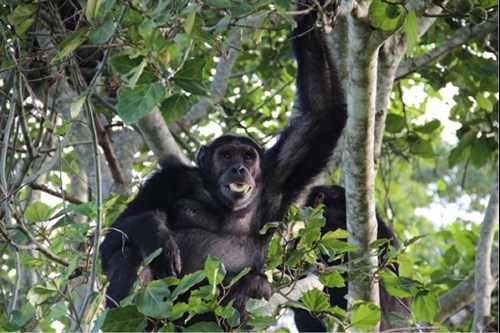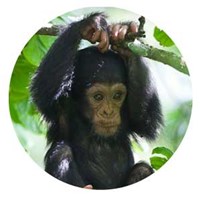Habituating the Waibira community
28/12/2016 in Conservation
The Waibira chimpanzee community is the second to be habituated by the Budongo Conservation Field Station, after the Sonso community. The process has been very successful and even in the first few years we could find and follow the chimpanzees on a daily basis. Now, after six years, habituation is quite good and has taken a shorter time than the same process previously took in Sonso. We believe that this can be attributed to two things:– firstly the very hard work of our Waibira staff and researchers! From the start of habituation we had a policy of low-impact flexible encounters, where, as much as possible, we try to allow the behaviour of the chimpanzees to dictate the pace of habituation. While this approach can seem to go slowly at the start, it appears to pay off in the long-term. Secondly, our secret weapon, Sonso ladies! We were extremely lucky to have regular emigrations of fully habituated female chimpanzees from the neighbouring Sonso community to the Waibira group. Unlike male chimpanzees, who remain within the communities in which they were born, female chimpanzees often migrate between groups when they approach adulthood as a way of avoiding inbreeding.

Above: A chimpanzee feeding on the fruit of the common guava.
Nora and Bahati were the first Sonso females that were confirmed to have migrated to Waibira community (in around 2009-2010). When the habituation process started back in 2011, on our very first day following the chimpanzees we found Nora, and then met Bahati not long after. The two were well received and quickly attracted many male admirers. Having been fully habituated whilst still in the Sonso community as youngsters, they were not afraid of human presence. The Waibira males, who were courting them as they came into season, had no choice but to stick around even when the field staff followed them as part of the habituation process. Over the years we have found more young adult Sonso female chimpanzees, Ketie may have immigrated before even Nora and Bahati but for a Sonso female was still quite shy and it took time for us to see her, now all three of them have young infants of their own. In 2014 our latest immigrant - Monika - moved over and the four Sonso females can often be found together. They may compose a small number of their new community but their presence has had a noticeable effect on this latest habituation process. The diet in Waibira is rather different from what they used to enjoy in Sonso. In Sonso the presence of non-native species such as Broussonetia papyrifera (Paper mulberry) provide a regular year round found source, in Waibira they are dependent on the native species, and in the large territory sometimes have to travel far to find something in season. So far in the habituation process, we have been able to identify and name up to 90 individuals within the Waibira community. These include 23 males, 30 females and 37 immature individuals. Just as in Sonso there are also a number of peripheral females associated with this community that are sometimes not seen for months or even years. But here we also have another secret weapon – our waterhole camera trap where we sometimes see females that we’ve still never met –so the whole community may number 120 individuals. Kevilee, a 35-year old male is our current alpha , and is often found with his partner-in-crime, the gentle giant Ursus.
Another key player is the older male Talisker – we suspect he’s an ex-alpha and, while he’s not officially the boss anymore, he continues to receive a lot of respect. The hierarchy seems quite settled at the moment, but with so many large males in one group the politics can be a challenge to keep up to date with!
Having a second chimpanzee community fully habituated will open up lots of new opportunities for researchers at the field station and I look forward to updating you on this work in future posts.
Until next time,
Jacintha N. Lwebuga
BCFS Communication Coordinator
 Help support our work
Help support our work
The Royal Zoological Society of Scotland (RZSS) is an independent charity. We receive no direct government funding and rely on the generosity of supporters just like you.
Find out how you can help support our conservation work in projects like those described in this blog, as well as many others, via the link below:
Featured Articles

An update from the Budongo Forest
19/04/2024 in Conservation

Edinburgh Zoo named best zoo in Scotland
15/04/2024 in Edinburgh Zoo
Latest News
-
Blog

19/04/2024
An update from the Budongo Forest
The Budongo Conservation Field Station (BCFS) in Uganda is one of our wildlife conservation charity’s longest partnerships.
-
Blog

02/02/2021
Celebrating sixteen years of partnership with BCFS
The Royal Zoological Society of Scotland (RZSS) has partnered with the Budongo Conservation Field Station (BCFS) in Uganda since 2005. For 16 years we’ve worked together to protect the Budongo Forest and the 800 chimpanzees who call it home.
-
Blog

01/12/2020
Budongo Conservation Field Station Update
Your support has protected the chimpanzees of the Budongo Forest in Uganda for over 15 years, and this year it has meant more than ever.
-
Blog

13/04/2020
RZSS Goes Wild conservation video series
From our conservation team's living room, to yours! Our new #RZSSGoesWild web series will take you around the world via the amazing wildlife conservation projects we support.

























Follow EZ